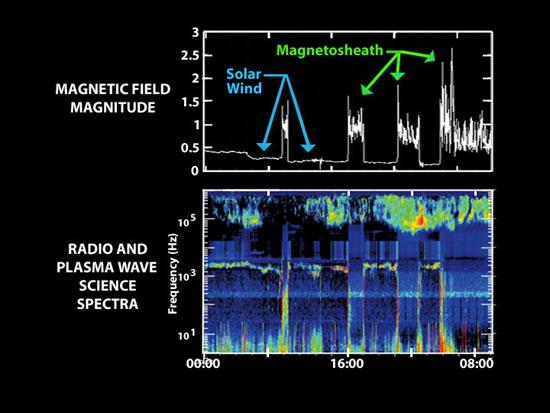This graph illustrates the series of sonic booms that took place when the Cassini spacecraft crossed Saturn's bow shock. A bow shock is a shock wave located where incoming solar wind meets a planet's magnetosphere, or magnetic bubble. Differences in electrical charges cause the solar wind to curve around the magnetosphere in the same way that air flows around a supersonic airplane. The resulting turbulence is heard as a sonic boom and is represented here as an increase in wave frequency.
Scientists were surprised to discover that Saturn's bow shock was located at a distance of 3 million kilometers (1.9 million miles) from Saturn, much farther out than they had predicted.
Because the bow shock acts like a balloon when hit, oscillating in and out, Cassini actually crossed it several times, resulting in the seven sonic booms depicted above. Red denotes louder waves, and blue quieter. This data was taken by Cassini's radio and plasma wave science instrument.
The Cassini-Huygens mission is a cooperative project of NASA, the European Space Agency and the Italian Space Agency. The Jet Propulsion Laboratory, a division of the California Institute of Technology in Pasadena, manages the Cassini-Huygens mission for NASA's Office of Space Science, Washington, D.C. The Cassini orbiter was designed, developed and assembled at JPL. The radio and plasma wave science instrument team is based at the University of Iowa, Iowa City.
For more information about the Cassini-Huygens mission, visit http://saturn.jpl.nasa.gov and the instrument team's home page, http://www-pw.physics.uiowa.edu/plasma-wave/cassini/home.html .
Image Credit:
NASA/JPL/University of Iowa

